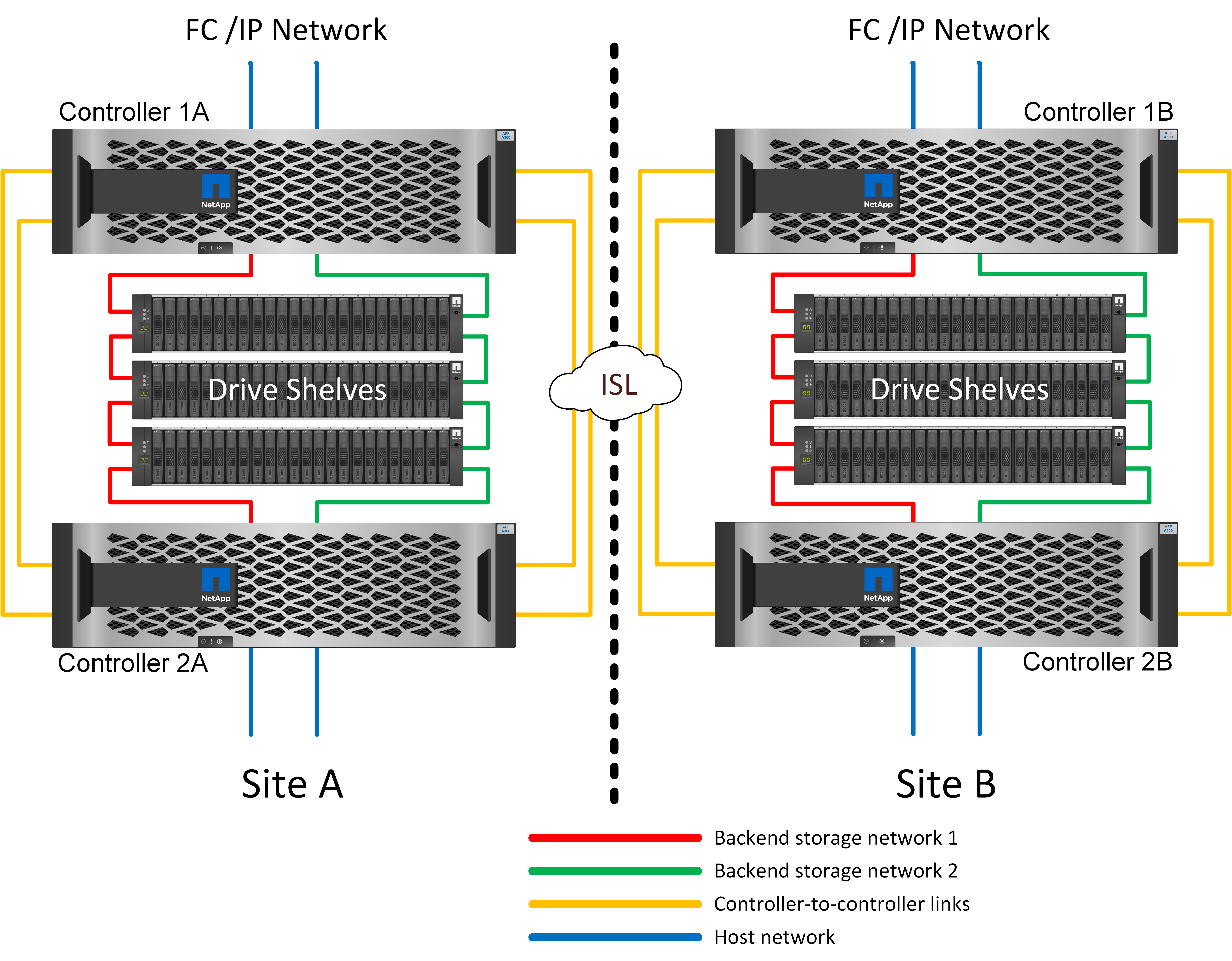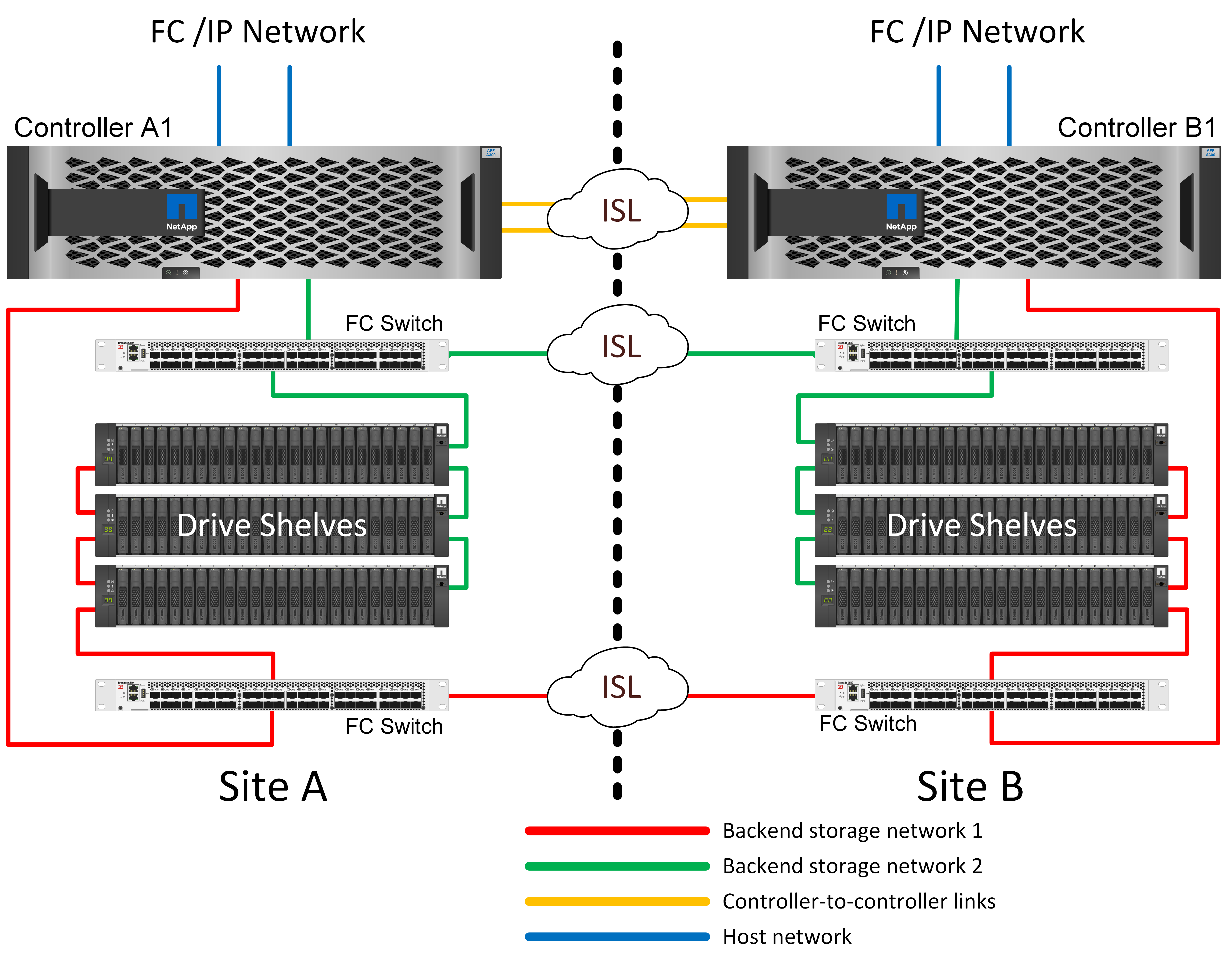Architecture
 Suggest changes
Suggest changes


Microsoft SQL Server deployment with MetroCluster environment requires some explanation of physical design of a MetroCluster system.
MetroCluster synchronously mirrors data and configuration between two ONTAP clusters in separate locations or failure domains. MetroCluster provides continuously available storage for applications by automatically managing two objectives:
-
Zero recovery point objective (RPO) by synchronously mirroring data written to the cluster.
-
Near zero recovery time objective (RTO) by mirroring configuration and automating access to data at the second site.
MetroCluster provides simplicity with automatic mirroring of data and configuration between the two independent clusters located in the two sites. As storage is provisioned within one cluster, it is automatically mirrored to the second cluster at the second site. NetApp SyncMirror® provides a complete copy of all data with a zero RPO. This means that workloads from one site could switch over at any time to the opposite site and continue serving data without data loss. MetroCluster manages the switchover process of providing access to NAS and SAN-provisioned data at the second site. The design of MetroCluster as a validated solution contains sizing and configuration that enables a switchover to be performed within the protocol timeout periods or sooner (typically less than 120 seconds). This results in a near zero RPO and applications can continue accessing data without incurring failures.MetroCluster is available in several variations defined by the back-end storage fabric.
MetroCluster is avialable in 3 different configurations
-
HA pairs with IP connectivity
-
HA pairs with FC connectivity
-
Single controller with FC connectivity

|
The term 'connectivity' refers to the cluster connection used for cross-site replication. It does not refer to the host protocols. All host-side protocols are supported as usual in a MetroCluster configuration irrespective of the type of connection used for inter-cluster communication. |
MetroCluster IP
The HA-pair MetroCluster IP configuration uses two or four nodes per site. This configuration option increases the complexity and costs relative to the two-node option, but it delivers an important benefit: intrasite redundancy. A simple controller failure does not require data access across the WAN. Data access remains local through the alternate local controller.
Most customers are choosing IP connectivity because the infrastructure requirements are simpler. In the past, high-speed cross-site connectivity was generally easier to provision using dark fibre and FC switches, but today high-speed, low latency IP circuits are more readily available.
The architecture is also simpler because the only cross-site connections are for the controllers. In FC SAN attached MetroClusters, a controller writes directly to the drives on the opposite site and thus requires additional SAN connections, switches, and bridges. In contrast, a controller in an IP configuration writes to the opposite drives via the controller.
For additional information, refer to the official ONTAP documentation and MetroCluster IP Solution Architecture and Design.

HA-Pair FC SAN-attached MetroCluster
The HA-pair MetroCluster FC configuration uses two or four nodes per site. This configuration option increases the complexity and costs relative to the two-node option, but it delivers an important benefit: intrasite redundancy. A simple controller failure does not require data access across the WAN. Data access remains local through the alternate local controller.

Some multisite infrastructures are not designed for active-active operations, but rather are used more as a primary site and disaster recovery site. In this situation, an HA-pair MetroCluster option is generally preferable for the following reasons:
-
Although a two-node MetroCluster cluster is an HA system, unexpected failure of a controller or planned maintenance requires that data services must come online on the opposite site. If the network connectivity between sites cannot support the required bandwidth, performance is affected. The only option would be to also fail over the various host OSs and associated services to the alternate site. The HA-pair MetroCluster cluster eliminates this problem because loss of a controller results in simple failover within the same site.
-
Some network topologies are not designed for cross-site access, but instead use different subnets or isolated FC SANs. In these cases, the two-node MetroCluster cluster no longer functions as an HA system because the alternate controller cannot serve data to the servers on the opposite site. The HA-pair MetroCluster option is required to deliver complete redundancy.
-
If a two-site infrastructure is viewed as a single highly available infrastructure, the two-node MetroCluster configuration is suitable. However, if the system must function for an extended period of time after site failure, then an HA pair is preferred because it continues to provide HA within a single site.
Two-node FC SAN-attached MetroCluster
The two-node MetroCluster configuration uses only one node per site. This design is simpler than the HA-pair option because there are fewer components to configure and maintain. It also has reduced infrastructure demands in terms of cabling and FC switching. Finally, it reduces costs.

The obvious impact of this design is that controller failure on a single site means that data is available from the opposite site. This restriction is not necessarily a problem. Many enterprises have multisite data center operations with stretched, high-speed, low-latency networks that function essentially as a single infrastructure. In these cases, the two-node version of MetroCluster is the preferred configuration. Two-node systems are currently used at petabyte scale by several service providers.
MetroCluster resiliency features
There are no single points of failure in a MetroCluster solution:
-
Each controller has two independent paths to the drive shelves on the local site.
-
Each controller has two independent paths to the drive shelves on the remote site.
-
Each controller has two independent paths to the controllers on the opposite site.
-
In the HA-pair configuration, each controller has two paths to its local partner.
In summary, any one component in the configuration can be removed without compromising the ability of MetroCluster to serve data. The only difference in terms of resiliency between the two options is that the HA-pair version is still an overall HA storage system after a site failure.
SyncMirror
Protection for SQL Server with MetroCluster is based on SyncMirror, which gives a maximum-performance, scale-out synchronous mirroring technology.
Data protection with SyncMirror
At the simplest level, synchronous replication means any change must be made to both sides of mirrored storage before it is acknowledged. For example, if a database is writing a log, or a VMware guest is being patched, a write must never be lost. As a protocol level, the storage system must not acknowledge the write until it has been committed to nonvolatile media on both sites. Only then is it safe to proceed without the risk of data loss.
The use of a synchronous replication technology is the first step in designing and managing a synchronous replication solution. The most important consideration is understanding what could happen during various planned and unplanned failure scenarios. Not all synchronous replication solutions offer the same capabilities. If you need a solution that delivers a recovery point objective (RPO) of zero, meaning zero data loss, all failure scenarios must be considered. In particular, what is the expected result when replication is impossible due to loss of connectivity between sites?
SyncMirror data availability
MetroCluster replication is based on NetApp SyncMirror technology, which is designed to efficiently switch into and out of synchronous mode. This capability meets the requirements of customers who demand synchronous replication, but who also need high availability for their data services. For example, if connectivity to a remote site is severed, it is generally preferable to have the storage system continue operating in a non-replicated state.
Many synchronous replication solutions are only capable of operating in synchronous mode. This type of all-or-nothing replication is sometimes called domino mode. Such storage systems stop serving data rather than allowing the local and remote copies of data to become un-synchronized. If replication is forcibly broken, resynchronization can be extremely time consuming and can leave a customer exposed to complete data loss during the time that mirroring is reestablished.
Not only can SyncMirror seamlessly switch out of synchronous mode if the remote site is unreachable, it can also rapidly resync to an RPO = 0 state when connectivity is restored. The stale copy of data at the remote site can also be preserved in a usable state during resynchronization, which ensures that local and remote copies of data exist at all times.
Where domino mode is required, NetApp offers SnapMirror Synchronous (SM-S). Application-level options also exist, such as Oracle DataGuard or SQL Server Always On Availability Groups. OS-level disk mirroring can be an option. Consult your NetApp or partner account team for additional information and options.


